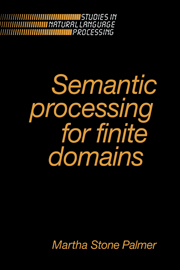3 - A domain formalization
Published online by Cambridge University Press: 24 November 2009
Summary
This chapter presents the formalization of the pulley domain. In this domain, the entities involved tend to be simple solid entities like particles and strings, while the relationships between them include notions of support, contact, or motion of some form. Section 3.2 describes the formalization of the pulley world in terms of the types of entities and their properties. The relationships are used for the decompositions of the verbs which are described in section 3.3 where the lexical entries of the verbs are listed. Each verb is subcategorized in terms of the primary relationship involved in the decomposition. The semantic roles are arguments of these relationships. The lexical entries include the decompositions of these primary relationships. Section 3.5 introduces the mapping constraints for assigning syntactic constituents to semantic roles. Examples demonstrate how the syntactic cues can be used with predicate environments to preserve the same semantic role interdependences that are preserved by templates. The last section describes the semantic constraints used in conjunction with the mapping constraints to test that the referent of a syntactic constituent is of the correct semantic type. The last category of constraints described, the pragmatic constraints, are used by inference-driven mapping to fill semantic roles that do not have mappings to syntactic constituents. Chapter 4 describes how inference-driven mapping interprets the lexical entries procedurally to drive the semantic analysis of paragraphs of text.
- Type
- Chapter
- Information
- Semantic Processing for Finite Domains , pp. 68 - 110Publisher: Cambridge University PressPrint publication year: 1990

